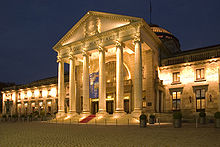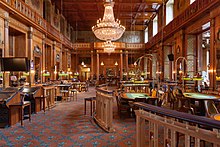Wiesbaden Casino

The Wiesbaden casino is one of the best-known and most traditional casinos in Germany .
Game offer
The casino consists of the big game ( roulette , blackjack , poker ), which is housed in the former wine hall of the Kurhaus , and the small game ( slot machine ) in the adjacent Kurhaus colonnades , which are the longest columned hall in Europe with a length of 129 m .
The Wiesbaden Casino has a special feature for the roulette game, the Wiesbaden Super Roulette : Without additional bets and activities on the part of the player, it is possible to play two, three, four or even two, three, four or even games with normal roulette at all roulette tables Win five times the normal: Above the permanent display are five reels with the numbers 0 to 36, which are started like a slot machine . If after the stop you can see a "pair" and the number that appears twice matches the winning number in the roulette wheel, the win for all winning sets in the number field on this table - whether on Plein, Cheval, Carré or the transversal - is shown. doubled. If three random numbers (three of a kind) that match the winning number appear on the reel display, it is tripled. This goes up to fivefold if the same number remains on the reels five times and this is identical to the winning number at the table. The event of a “super number” is announced to the audience by a fanfare, which is all the more pompous, the greater the multiplication of the profit. The "Wiesbadener Super Roulette" is a patented invention of the gaming technician Gerhard Schmulder.
In the beginning, the roulette variant Roulite was also unique : like an oversized “race track” in American roulette, the betting fields for the numbers are arranged in the same order as the numbers in the roulette wheel. This makes it much easier for secondary number players to set their combinations.
history
Until 1872
Prince Carl von Nassau-Usingen issued on January 31/14. February 1771 a privilege for gambling in Wiesbaden after the lottery, which had been introduced two years earlier, had been discontinued after a year. At that time they were still played in inns.
Roulette was introduced just eleven years later, and in 1810 the casino was moved to the newly built Old Kurhaus . In Nassau, the ban on gambling outside of privileged health resorts was introduced, i. H. Subjects and officials were forbidden to play.
When casinos in France were closed by the Prohibition Act of 1831 on the New Year of 1838 , their tenants looked for new places to work. Antoine Chabert, previously a concessionaire in Baden-Baden , acquired the gaming monopoly in the Duchy of Nassau on February 14, 1834, with the casinos in Bad Ems , Wiesbaden, Schlangenbad and Schwalbach . The Wiesbaden operation ran brilliantly, not only for the city but also for the tenant, who ceded it to Anton Gutz on October 5, 1847 and moved away with 7 million francs .
In 1872 the casinos in the German Empire were closed by a Reich law .
Since 1946
As early as 1946, the US occupiers issued a license to play games, but resistance from the Hessian state government prevented it from starting until the end of 1948. At the same time, there were protracted arguments about the license for the big game. Finally, the group around the Offenbach leather manufacturer Dr. Julius Steinmann and the Romanian of Mexican nationality Carol Nachmann (1897–1993) with a criminal record for illegal gambling abroad .

The Wiesbaden big game did not begin again until after the Second World War on October 29, 1949, initially in the foyer of the Hessian State Theater , and since 1948 there was the "skill game" Okulus. Six years later, on November 3, 1955, the casino under director Edgar Neuland was able to reopen at its traditional location in the north wing of the Kurhaus, which had been used by the US troops until then . The little game began on August 25, 1956 in the former restaurant.
The upcoming extension of the concession meant that Neuland KG acted as a tenant. Nachmann continued to play a leading role. Renewals take place every five years. In October 1980 there was a bidding war. On the one hand there was the "marriage" of the previous operator with the company of the hotel chain operator Egon Steigenbergers (who also ran Baden-Baden ) and a group around the Frankfurt real estate and jewelry dealer Ignatz Bubis . On the other hand, the journalist Botho Jung and his sponsors and the Munich restaurateur Gerd Käfer offered . The former won the concession again, probably not without cheating, but Steigenberger was now in charge.
The day-to-day operations as head of the casino were taken over by the former head of the hall, Joachim Kockel, on April 30, 1982, when extensive renovation work was in progress. Fritz Lederer became director. In the fountain colonnade, the slot machine room, the "Golden 13th", was opened. Since the restoration of the Kurhaus, the casino ( Großes Spiel ) has been located in its former wine room. This neoclassical hall with its wall and ceiling paneling made of cherry wood and the sweeping crystal chandeliers offers the casino a festive atmosphere. Also in 1986 - in this year the residence ban of 1771 was lifted on March 1st - the concession remained in the hands of the group around Nachmann-Steigenberger-Bubis, although there were four opposing candidates, including Beetles. Horst Weißengruber († January 11, 2010) was recruited from Reichenhall as managing director . The gross gaming revenue rose from twenty million DM in 1981 to 26 million DM in 1988. " American Roulette " was offered in March 1989.
The next time the license was extended, the Achterfeld & Jahr group around Hamburg casino professional Wilfried Achterfeld with John Jahr and Gerd Käfer came into play from January 1991 . Spielbank Wiesbaden GmbH & Co. was founded as the management company, with Klaus Gülker as its boss . He was supported by Gerhard Schmulder as technical manager.
" Seven Card Stud Poker" began in 1993. In the same year the gross profit reached 46.6 million. The lease was extended in 2000, 2005 and then in 2009, this time with a 10-year term. Thomas Freiherr von Stenglin was (co-) director in 2004 until his dismissal at the end of 2011. Andreas Krautwald , who previously worked in Homburg , became the new managing director . The casino has around 200,000 visitors annually.
literature
- The Wiesbaden casino achieved international fame through the writer Fyodor Michailowitsch Dostojewski . On his first visit in September 1863 he was initially lucky (profit: 10,400 francs). On his second trip abroad in 1865 he wanted to try again and lost all of his travel budget. In 1866, in just 26 days, he created his short novel The Player , which is now one of the classics of world literature.
- Manfred Gerber: The Kurhaus Wiesbaden. Kaleidoscope of a century. Monuments publications of the German Foundation for Monument Protection. Bonn 2007, ISBN 978-3-936942-84-2 .
- Erhard Niedenthal ; The game in Wiesbaden. Verlag Marianne Breuer, Wiesbaden 1997, ISBN 3-9804701-1-3 . (Commissioned work for the 225th anniversary celebration)
- Hans Dieter Schreeb: Millions of studies: Multatuli and the Wiesbaden casino. Verlag Corso, Wiesbaden 2004, ISBN 3-9808862-1-2 .
Web links
References and comments
- ↑ Isa Guide, published on March 22, 2004: The Wiesbaden casino reinvents the AmRoul table for Gerhard Schmulder
- ^ Law on the closure and restriction of public casinos of July 1, 1868
- ^ Message from the Hessian Minister of Economics to the Prime Minister on May 19, 1949, quoted in in Niedenthal (1997), pp. 106f. See. I am not bribed. In: Der Spiegel. No. 46, November 16, 1949.
- ^ Frankfurter Allgemeine Zeitung. July 6, 2012, No. 155, p. 50.
Coordinates: 50 ° 5 ′ 6 ″ N , 8 ° 14 ′ 49 ″ E


